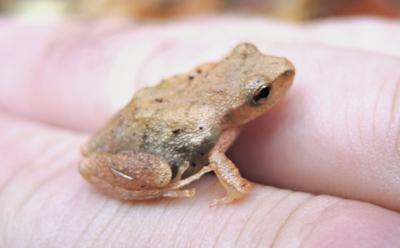Nature Notes: Sing Hallelujah!

“Here it comes, here it comes, here it comes. . . .” No, not “my 19th nervous breakdown,” as Mick Jagger sang, but spring, spring, spring!
I went out to this pond and that one in Sag Harbor and East Hampton’s Northwest Woods on a rainy, blustery Monday night to see if it was really true. I had a little amplifying gizmo with two earphones and whenever I stopped by the side of a pond, I turned it on. And what did I hear at each stop? Spring peepers, spring peepers, spring peepers, peep, peep, peeping away. It must be spring, I thought, and it was.
Victoria Bustamante has been hearing peeper calls in Montauk since last Thursday. It wasn’t wet, but it was unseasonably warm. If peepers were calling that early, other signs of spring should be just around the corner, and they were. Howard Reisman, who watches the North Sea Harbor tributary to Big Fresh Pond like a hawk, sent me an email Sunday morning: “Two dead alewives at the Noyac Road culvert this morning.” The rush was on.
Alewives have been passing under Noyac Road and then under North Sea Road on their way to Big Fresh Pond annually for more than 100 years without a hitch and for hundreds of years before that when there was just a culvert-less stream to ascend to get to their traditional spawning grounds. Conscience Point, around the corner on North Sea Harbor, was where white colonists from Connecticut first landed to settle Southampton in 1640. They arrived at about the same time the alewives were running, a promising sign for a handful of newcomers who didn’t know what to expect when they set foot on the new land for the first time.
When alewives come back, so do the ospreys. The two species go hand in hand. Old-timers remember when ospreys were as common as robins, especially on the North Fork, where there were so many that they ran out of trees to nest in and started building their nests on utility poles. A few even built their nests on sandy spits or huge glacial erratics rising above the surface of the bay.
Then suddenly in the 1960s, they began to lay eggs that never hatched, the population plummeted, and by 1980 there were less than 30 pairs on the South and North Forks and all the islands in the Peconics. DDT and other chlorinated hydrocarbon pesticides were to blame. Now, in the absence of those pesticides, the ospreys are making a comeback, but they will probably never reach the numbers achieved before the crash. They only seem to use artificial nesting platforms on which to raise their young. An osprey nest in a tree on Long Island has become a great rarity.
Alewives running in from the sea, peepers out of hibernation and peeping, ribbon snakes emerging from their winter sleep to feed on unwary peepers, just-back ospreys carrying sticks in their talons, just-up chipmunks scrambling to find leftover nuts, and, of course, the usual hordes of robins, grackles, and red-winged blackbirds singing and calling, and the occasional mourning cloak butterfly flittering about. . . . How can it be anything but spring?
We have lots of early spring birds, not just the ones mentioned above. We also have the piping plover and the killdeer, the yellow-rumped warbler and the pine warbler, the fish crow and the vulture. A new spring bird has landed on Long Island and chosen to make its home here for the first time in almost a century. It’s the bald eagle, one of the earliest of nesters, rivaling the great-horned owl in that respect. There are four bald eagle nests in progress on eastern Long Island.
Females have already laid some eggs and are already incubating them. Terry Sullivan, one of our select eagle spotters, thinks he may have a nest in progress right here on the South Fork. Funny, bald eagles still nest in trees. Can you imagine our national bird nesting on a platform fashioned out of 2-by-4s? It would surely be a fall from grace.
So there your have it. We humans have just set our clocks an hour ahead, while in clockwork precision the natural harbingers of spring that fly, croak, slither, swim, and run on all fours are back. Isn’t it just grand? And did I not mention ticks?
Larry Penny can be reached via email
